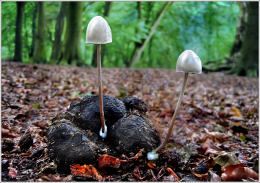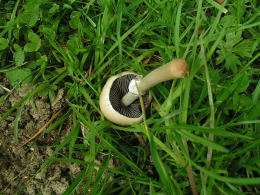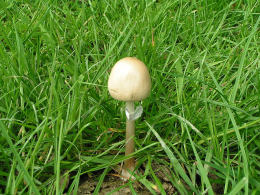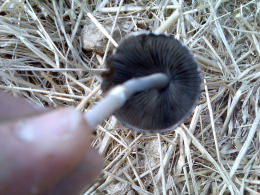 |
 |
 |
| synonyms: Egghead Mottlegill, Ring-D�ngerling |
 |
|
|
 |
| location: North America, Europe |
| edibility: Inedible |
| fungus colour: White to cream, Grey to beige |
| normal size: 5-15cm |
| cap type: Other |
| stem type: Ring on stem, Stem much longer than cap diameter |
| flesh: Mushroom slimy or sticky |
| spore colour: Purplish to black |
| habitat: Grows on plant material/manure |
 |
Panaeolus semiovatus (Sow. ex Fr.) Lund. syn. Anellaria separata (L. ex Fr.) Karst. syn. P. separatus (L. ex Fr.) Gillet Ring-D�ngerling Egghead Mottlegill. Cap 2�6cm across, ovate-bell-shaped, never expanding, clay white tinged yellowish towards centre, viscid, drying shiny, velar remnants often adhering to margin. Stem 50�100 x 4�8mm, slightly thickened at base, whitish; ring white and membranaceous, persistent. Flesh whitish, yellowish in stem. Gills broad, whitish, soon brown-black, often with a white edge. Pleurocystidia in form of broad lanceolate chrysocystidia with pointed apices. Spore print black. Spores pip-shaped, 16�20 x 10�12um. Habitat on dung. Season spring to early winter. Occasional. Not edible. Distribution, America and Europe.
|
 |
Members' images and comments
|
Click here
to upload and share your photos and comments about this mushroom (JPEG only please).
|
 |
 |
 |
Tony Wharton (United Kingdom) - 26 October 2025

Photographed on horse dung in Piper's Hill Wood, Worcestershire.
|

|
 |
Ricky Rasquedo (United Kingdom) - 28 June 2025

Found growing on cow dung in late May, North Wales.
|

|
 |
Ricky Rasquedo (United Kingdom) - 28 June 2025

Found growing on cow dung in late May, North Wales.
|

|
 |
Adrian Shaw (United Kingdom) - 12 April 2025

I'm not sure what species this is but it looks and seems the same. found on horse dung/hay
|

|
 |
|
 |
|
By uploading images and text you hereby warrant that you are the legal owner of this
material and agree, without limitation, to permit Rogers Plants Ltd to publish such
images and text on this Rogers Plants website. Rogers Plants Ltd reserves the right
to remove any member images or text at its sole discretion.
|

